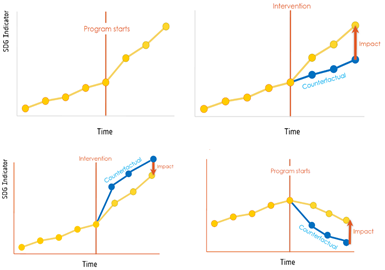ESA projects in Sub-Saharan Africa are demonstrating how humankind can benefit from space technology by showing observable impact on a wide range of Sustainable Development Goals (SDGs).

Céline Dubron and Elia Montanari from ESA Space Solutions produced several case studies analysing projects which had turned global challenges into business opportunities – with statistically significant SDGs effects. Here we take a closer look at two out of 17 of the ESA projects implemented in Sub-Saharan Africa.
CASE STUDY: Sway4Edu
Combining operational and human aspects from the start was key in improving learning processes, boosting the interest of teachers and children developing IT skills. It also facilitated the creation of virtual learning communities among schools in the network. Teachers who were initially apprehensive about using ICT gradually became enthusiastic supporters of e-learning, and were even awarded recognition for their creativity in producing e-based learning material. In order to support e-learning services and internet access in rural schools of developing countries Sway4edu developed a satellite ICT (Information and Communication Technology) solution, with the necessary tools and methodology to integrate it into daily life. Schools quickly took ownership of the initiative, with the support of the local education authority.
The application was implemented in South Africa and Mali (the treatment group). The control group was composed of Niger and Namibia – (chosen because they showed similar trends before implementation of the application).
The team found a significant impact on the SDG indicator in the countries receiving the application.
![]() SDGs Indicator 4.a.1: Proportion of schools with internet access for pedagogical purposes.
SDGs Indicator 4.a.1: Proportion of schools with internet access for pedagogical purposes.

CASE STUDY: SatFinAfrica
SatFinAfrica is a project set up to provide reliable and secure financial services in remote/underserved areas in African emerging countries. It enables secure and reliable financial applications such as money transfers, via a satellite-based telecommunication platform. The application has been implemented in a large number of countries: Cameroon, Uganda, Zambia, Guinea, Rwanda, Botswana, Kenya. For statistical relevance, an equally large control group: Egypt, Algeria, Lesotho, Morocco, Mozambique, Comoros, Djibouti, Sudan, Congo was used.
The data used for this case study was expressed as remittances, received as a percentage of GDP (remittances are funds transferred from migrants to their home country). Significant impact was observed: In the countries receiving this application, personal remittances increased by 0.1 % of GDP.
![]() SDGs Indicator 17.3.2: Volume of remittances as a proportion of total GDP.
SDGs Indicator 17.3.2: Volume of remittances as a proportion of total GDP.

Conclusion
These case studies demonstrate a tangible impact – not only at a grassroots level but also on the SDGs, promoting long-term global sustainability.
The methodology used for these case studies is explained more fully below.
Methodology
In order to assess statistical impact, the two case studies were reviewed against SDGs where sufficient time from deployment of the products and services had elapsed and data was available to perform impact analysis.
To measure the impact of a programme (or in this case; space application), the Difference in Difference (DID) methodology was used. This is a statistical technique which mimics a Randomised Controlled Trial as shown in figure 1; the impact of a programme is measured while taking into account a ‘counterfactual’. A counterfactual is defined as the trend we would have observed in case of no intervention.
This way it is possible to measure the effect of a treatment on a ‘treatment group’. As a counterfactual the team used a ‘control group’, i.e. similar countries with a comparable trend before the start of a programme.



